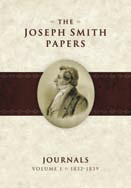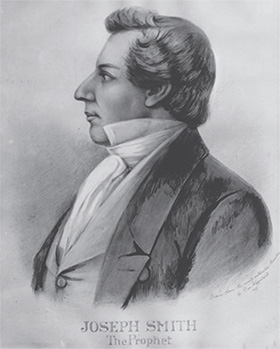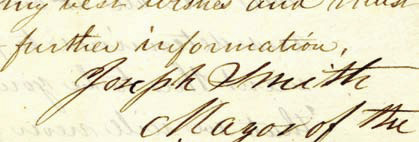Compiled by Brent R. Nordgren

Elder Marlin K. Jensen, Church historian and recorder, said, “The Joseph Smith Papers project is the single most significant historical project of our generation.” November marked the release of The Joseph Smith Papers, Journals, Vol. 1: 1832–1839. Because several faculty members from the Department of Church History and Doctrine are involved in the Joseph Smith Papers Project and will publish documents created by Joseph Smith or by his staff whose work he directed, we have included information that will help our readers keep up-to-date on this important project. The project also includes papers received and owned by Joseph Smith’s office. These key documents include, especially, the diaries, outgoing and incoming correspondence, revelations, contemporary reports of discourses, minutes, and editorials.
About the Volumes
When completed, The Joseph Smith Papers will consist of more than thirty volumes in six series: Journals, Documents, Revelations and Translations, History, Legal and Business, and Administrative. Three volumes of Joseph Smith’s journals cover the years 1832 through 1844. The Documents Series, in approximately eleven volumes, spans 1828 to 1844. At least four volumes—manuscript revelation books, other early revelation manuscripts including key Joseph Smith translation manuscripts, the Book of Mormon printer’s manuscript, and published Joseph Smith–era scripture—will make up the Revelations and Translations Series. Seven volumes of history encompass the period from 1805 to 1844. The Legal and Business Series has at least three volumes that include records of cases occurring in New York, Ohio, Missouri, and Illinois. Administrative records will publish minute books and letter books.
Typical Questions
Why was the project undertaken?
Producing a definitive, scholarly edition of Joseph Smith’s papers will allow increased and better scholarship on Joseph Smith and early Mormonism. Scattered documents will be gathered into one multivolume source, and manuscripts of varying legibility will be carefully transcribed and verified. In addition to making the content of these documents more accessible, transcription and publication will help preserve these delicate documents, which are subject to the ravages of age and handling and to possible damage from water, fire, and insects.

How many volumes will be published?
It is expected that the transcriptions will eventually constitute about thirty volumes. Publication began in 2008, with about two volumes published each year until the project is complete.
How many Joseph Smith documents still exist?
While the Joseph Smith Papers Project control file currently includes about 6,000 items, it is estimated that about 2,500 will qualify as featured texts. This is because a sent or received letter (for example) might also have been copied into a letter book or published in a church newspaper. A revelation may have been written down by a scribe, copied by another person, included in a letter, published in a newspaper, or copied into a manuscript compilation of revelations. Each of these would be considered a separate document, and part of the work of the project is determining the most original version of a document to feature. All versions, however, will be listed in a calendar of documents. The project control file also has entries for documents known to have existed but which have not been found.
How does the project ensure that scholarly standards are maintained?
A qualified, well-trained staff adheres to the best professional standards in transcription, verification, and documentary editing. The project also conducts various levels of internal and external review on each volume. An external national advisory board reviews each volume and acts as consultants for the project. The four-member board, recognized scholars in American religious history and documentary editing, is made up of one Latter-day Saint scholar and three scholars of other faiths.
What is an example of a doctrinal insight from the project?
Dr. Steven C. Harper, one of the editors on the project, explains that no revelation more emphatically sets forth the law of consecration than section 104:13–18. The Lord declares the first principle of consecration—“the earth is the Lord’s” (Exodus 9:29)—repeatedly and with crystal clarity: “I, the Lord, stretched out the heavens, and built the earth, my very handiwork; and all things therein are mine” (D&C 104:14). Having made the earth, the Lord can decree the rules of stewardship and accountability over it. Indeed, he endowed mankind with agency to act on the ample, abundant earth as stewards. He also requires that the rich must share with the poor (v. 16): “Therefore,” the passage concludes, “if any man shall take of the abundance which I have made, and impart not his portion, according to the law of my gospel, unto the poor and the needy, he shall, with the wicked, lift up his eyes in hell, being in torment” (v. 18; emphasis added). This passage is wonderfully potent, drawing obviously on the New Testament story of Lazarus and the rich man in Luke 16.

The earliest manuscripts of this revelation link the Lord’s point even more closely with that passage in the Gospel of Luke to which this revelation alludes. The Kirtland Revelation Book, for example, says that if one does not share according to the Lord’s law “he shall with Dives lift up his eyes [in hell] being in torment.”[1] Dives is the Latin word for rich, and in the Middle Ages it was adopted as the name of the rich man in Christ’s story of the rich man and Lazarus in Luke 16:19–31, a fact that was probably better known in the 1830s than it is today. In the Savior’s story as recorded in Luke, the rich man had “fared sumptuously” in life while a “beggar named Lazarus” waited in vain for some of his table scraps. When the two men died, angels carried Lazarus into Abraham’s bosom while the rich man went to hell. “And in hell he lift up his eyes, being in torments,” ironically begging Lazarus to relieve his suffering. Section 104:18 evokes that story and applies it to Latter-day Saints. When the Church published this revelation as Section 98 in the 1835 Doctrine and Covenants, the name Dives was changed to “the wicked,” perhaps because the Latin name Dives is not found in the New Testament but comes from later lore. Even so, the presence of Dives in the earliest manuscripts makes the essential meaning of this passage unmistakable, namely that the rich in Zion who do not impart of their substance to the poor will, like the rich man in Christ’s story, someday regret that unrighteousness.
For more information about the Joseph Smith Papers Project, please visit http://
Notes
[1] Kirtland Revelation Book, 102, Church History Library.
